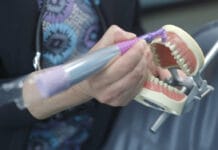A few years ago, I was told by a fellow hygienist that certain artificial sweeteners, specifically sorbitol, increased the risk of dental caries. I inquired about sources to support this claim, and the hygienist directed me to the dentist who provided this information to her.
I reached out to him on multiple occasions, and during these interactions, he assured me he would send me scientific literature to support this claim. Yet three years later, I haven’t received it, despite my follow-up inquiries.
I’m a firm believer that if you make a claim, you should always have evidence-based references to support the claim. However, in the real world, this rarely happens. Therefore, I set out to see what I could find regarding this topic. This article aims to provide evidence-based information on the effects of artificial sweeteners on oral health.
Oral bacteria that cause decay utilize sucrose, glucose, fructose, and other simple sugars to produce organic acids, which can lower the pH of the oral cavity, resulting in dental caries. Reducing the amount of sugar individuals are exposed to through food is a key factor in reducing dental caries. Reducing sugar intake often leads to replacing sugar with sugar substitutes.
Dental professionals should be aware of the effects, if any, these artificial sweeteners have on dental caries risk.1
Review of Artificial Sweeteners
According to the expanded Human Oral Microbiome Database, there are 774 oral bacteria species.2 Of those, P. gingivalis stands out as a key player in the onset and progression of periodontal disease. In the past, there have been reports that artificial sweeteners have antimicrobial effects on both P. gingivalis and A. actinomycetemcomitans.
In some cases, such as those with type 2 diabetes, some people who utilize artificial sweeteners are at an increased risk of developing periodontal disease. Therefore, a better understanding of the effects of artificial sweeteners on periodontal health is essential.3
Full disclosure, many of the studies cited for this article were done in vitro, which is of limited use clinically, yet a great starting point for further research to confirm the findings.
Xylitol and Erythritol
Sugar alcohols/polyols are a great option for artificial sweeteners as they have no or low fermentability in dental biofilm and promote remineralization and demineralization. However, all polyols, except for erythritol, have side effects such as abdominal discomfort, flatulence, softened stools, and diarrhea when consumed in excess. Being cognizant of the amount ingested is important to prevent side effects.1
Additionally, they are not recommended for children less than three years of age.1 The recommendation not to use polyols as a sweetener for children less than three years of age is limited to food consumption. In general, oral care products with polyols, such as xylitol, are safe for children with a few caveats from the American Academy of Pediatric Dentistry.4,5
The American Academy of Pediatric Dentistry (AAPD) released a policy for the use of xylitol in pediatric dentistry:5
- AAPD supports the use of xylitol and other sugar alcohols as noncariogenic sugar substitutes.
- AAPD recognizes that presently, there is a lack of consistent evidence showing a significant reduction in mutans and dental caries in children.
- AAPD recognizes that the large dose and frequency of xylitol used in clinical trials may be unrealistic in clinical practice.
- AAPD supports further research to clarify the impact of xylitol delivery vehicles, the frequency of exposure, and the optimal dosage to reduce caries and improve oral health in children.
Another polyol that has shown great promise in managing bacteria that cause periodontal disease is erythritol. Erythritol reduces biofilm formation and induces a shift from periodontitis-related species toward an ecology dominated by early colonizers, indicating that erythritol suppresses dental biofilm’s maturation and prevents dysbiosis that leads to periodontal disease.6
Sorbitol
Sorbitol is the artificial sweetener that started this journey. The claim is that S. mutans can ferment sorbitol. Though that claim is not entirely inaccurate, there is a bigger picture to better understand sorbitol as a safe artificial sweetener when it comes to oral health. First, these findings were in vitro, which, as mentioned, cannot be extrapolated to apply to clinical care. Additionally, the rate of acid production is much slower when compared to other fermentable disaccharides and hexoses. The slower rate of acid production allows salivary buffers to neutralize the acid that is produced.1
In a randomized clinical trial comparing xylitol gum and sorbitol gum on the effects of biofilm and saliva microbial communities. The clinical trial determined that “neither xylitol nor sorbitol treatments significantly affected the bacterial composition of plaque.”7 The results of the study indicated that Lactobacilli were undetected, and the number of S. mutans was very low and unaffected by either treatment.7
However, sorbitol increased the abundance of S. cristatus, an oral commensal known to inhibit bacterial pathogens associated with chronic periodontitis, possibly providing a protective effect against periodontal disease onset and progression.7
Additionally, a quantitative systematic review of clinical trials aiming to determine the effects of xylitol in comparison with sorbitol found that “the evidence identified in support of xylitol over sorbitol is contradictory, is at high risk for selection bias and may be limited by confounder effect.”8
What we know about sorbitol currently is that though some streptococci can ferment it, it does not increase or contribute to caries risk. Additionally, it may provide some protective effects against bacteria that cause periodontal disease.7,8
Lactitol and Maltitol
Lactitol is not easily metabolized by acidogenic and polysaccharide-forming microorganisms. Therefore, it does not contribute to dental caries or periodontal disease.
Maltitol does not lower oral pH, and recent studies show that it reduces the concentration of cariogenic bacteria, including S. mutans, in dental biofilm, providing a protective effect against the development of dental caries.1
Aspartame
Due to some unscientific assumptions and animal studies taken out of context, aspartame has been given a bad rap. For the record, there is no valid, robust scientific evidence that aspartame, when used properly, is carcinogenic.1
Despite the controversy, aspartame is noncariogenic. There have been no studies published to date to indicate it has any protective effect, as seen with polyols. Still, it certainly does not contribute to the incidence of dental caries.1
However, in a study evaluating growth inhibitory effects on P. gingivalis, aspartame showed growth inhibitory and bactericidal activity against P. gingivalis, indicating a possible protective effect against periodontal disease. Of interest, aspartame was the only artificial sweetener in the study that showed no cytotoxicity at high doses, further supporting safety.3
Acesulfame Potassium
Acesulfame potassium, also known as acesulfame-K or Ace K, is used in many oral care products as a sweetener. Studies show that acesulfame potassium reduces biofilm formation and S. mutans/S. sanguinis ratio, while increasing biofilm pH ultimately diminishing cariogenic capacity.1,9
Additionally, acesulfame potassium in vitro displays bactericidal effects against P. gingivalis. Unfortunately, the doses needed to elicit this response also elicited cytotoxicity. Therefore, the recommended safe doses may not provide bactericidal effects against P. gingivalis.3
Stevioside
Stevia is a popular non-caloric sweetener derived from the leaves of a small shrub, Stevia rebaudiana. In a study evaluating the inhibitory effects of stevia extract against S. mutans, it was determined that stevia extract exhibited superior inhibitory effects compared to chlorhexidine.1
In animal studies, stevia extract reduced alveolar bone resorption and inflammation and reduced P. gingivalis activity, biofilm formation, and virulence expression. The study concludes by stating that stevia may be a potential alternative to glucose for patients with periodontal disease.10
Sucralose
Sucralose, much like aspartame, is noncariogenic. There is no evidence it displays any protective effects against dental caries, but it does not contribute to the incidence of dental caries.1
Sucralose does have some inhibitory effects on P. gingivalis as well as bactericidal activity against P. gingivalis, but more studies are needed to clarify how this would translate clinically.3
Summation of Findings
The anticarcinogenic effects of sugar substitutes include the following:1
- Inhibition of insoluble glucan synthesis from sucrose by mutans
- Decrease in the number of mutans in whole saliva and biofilm
- Increase in the buffering capacity and pH of dental biofilm
- Interference with enamel demineralization and an increase in enamel remineralization
The effects of sugar substitutes on P. gingivalis include the following:3
- Inhibits growth of P. gingivalis
- Displays bactericidal activity
- Inhibits biofilm formation
- Exhibits bactericidal activity against bacteria in established biofilm
Conclusion
Though many of the artificial sweeteners mentioned have had misinformation circulating, it is important to know they are all safe when consumed following the FDA’s Acceptable Daily Intake (ADI) in mg/kg body weight. Extensive studies have been done to establish safety. Safety studies show no increase in cancer risk, blood pressure, lipid profile, and waist circumference.1
With the understanding that artificial sweeteners, in general, are safe to use and knowing some potentially provide protection from dental caries and periodontal disease, dental professionals should be open to discussing replacing some or most sugar intake with artificial sweeteners to reduce caries and periodontal risks.
Before you leave, check out the Today’s RDH self-study CE courses. All courses are peer-reviewed and non-sponsored to focus solely on pure education. Click here now.
Listen to the Today’s RDH Dental Hygiene Podcast Below:
References
- Gupta, M. Sugar Substitutes: Mechanism, Availability, Current Use and Safety Concerns – An Update. Open Access Macedonian Journal of Medical Sciences. 2018; 6(10): 1888-1894. https://www.ncbi.nlm.nih.gov/pmc/articles/PMC6236052/
- Human Oral Microbiome Database. (n.d.) Human Oral Microbiome Database. https://www.homd.org
- Shinohara, M., Maetani, M., Kitada, C., et al. Analysis of the Effects of Food Additives on Porphyromonas gingivalis. Pathogens. 2022; 11(1): 65. https://doi.org/10.3390/pathogens11010065
- Nayak, P.A., Nayak, U.A., Khandelwal, V. The Effect of Xylitol on Dental Caries and Oral Flora. Clinical, Cosmetic and Investigational Dentistry. 2014; 6: 89-94. https://doi.org/10.2147/CCIDE.S55761
- Policy on Use of Xylitol in Pediatric Dentistry. (2020). American Academy of Pediatric Dentistry. https://www.aapd.org/media/policies_guidelines/p_xylitol.pdf
- Janus, M.M., Volgenant, C.M.C., Brandt, B.W., et al. Effect of Erythritol on Microbial Ecology of In Vitro Gingivitis Biofilms. Journal of Oral Microbiology. 2017; 9(1): 1337477. https://doi.org/10.1080/20002297.2017.1337477
- Rafeek, R., Carrington, C.V.F., Gomez, A., et al. Xylitol and Sorbitol Effects on the Microbiome of Saliva and Plaque. Journal of Oral Microbiology. 2018; 11(1): 1536181. https://doi.org/10.1080/20002297.2018.1536181
- Mickenautsch, S., Yengopal, V. Effect of Xylitol versus Sorbitol: A Quantitative Systematic Review of Clinical Trials. International Dental Journal. 2012; 62(4): 175-188. https://doi.org/10.1111/j.1875-595X.2011.00113.x
- Zhu, J., Liu, J., Li, Z., et al. The Effects of Nonnutritive Sweeteners on the Cariogenic Potential of Oral Microbiome. BioMed Research International. 2021; 2021: 9967035. https://doi.org/10.1155/2021/9967035
- Han, W., Jiao, Y., Mi, S., et al. Stevioside Reduces Inflammation in Periodontitis by Changing the Oral Bacterial Composition and Inhibiting P. gingivalis in Mice. BMC Oral Health. 2023; 23(1): 550. https://doi.org/10.1186/s12903-023-03229-y














